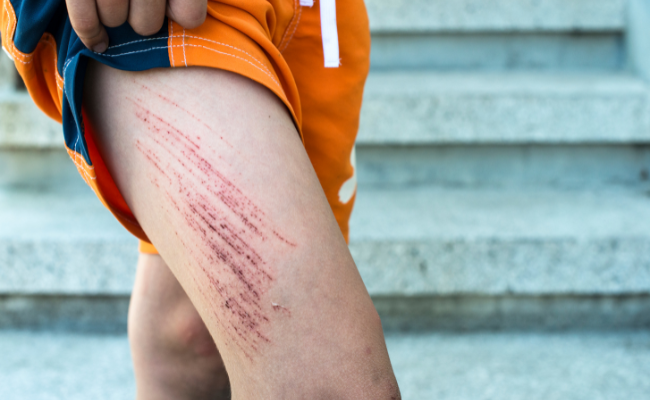How to Treat Cuts And Grazes?
- January 24, 2024
- No Comments

What are Cuts and Grazes?
Injuries involving damage to the skin's surface, such as cuts and grazes, are common in various situations, from routine kitchen accidents to outdoor mishaps or unexpected incidents. A cut typically results from contact with a sharp object, causing a visible separation or opening in the skin. Cuts often stem from encounters with sharp objects like knives, glass, or sheets of paper, yielding wounds marked by distinct openings. Conversely, grazes, also known as abrasions, arise when the skin experiences friction against a rough surface, resulting in superficial damage.
Lacerations, on the other hand, signify deeper cuts or tears in the skin, characterized by irregular and jagged edges. These injuries, whether cuts or grazes, manifest in different contexts, with grazes frequently occurring when individuals fall off skateboards or bikes, their bodies skimming across the ground. The term 'road rash' is commonly employed to describe such injuries, especially in cyclists or motorcyclists, where the skin comes into contact with and scrapes against the road surface.
Why is it Important to Treat Cuts and Grazes?
While cuts and grazes may seem minor, it is crucial to treat them promptly to prevent complications and promote optimal healing. Open wounds provide a gateway for bacteria and other pathogens to enter the body, increasing the risk of infection. Additionally, proper treatment can minimize scarring and discomfort, allowing for a faster recovery.
How to Treat Cuts and Grazes:
Step 1: Cleanse the Wound
The first step in treating cuts and grazes is to cleanse the wound thoroughly. Use mild soap and water to gently wash the affected area. Avoid harsh antiseptics or alcohol, as they can irritate the wound and delay healing. If there are foreign particles embedded in the cut or graze, use tweezers cleaned with rubbing alcohol to carefully remove them.
Step 2: Stop the Bleeding
If the cut is actively bleeding, apply gentle pressure with a clean cloth or sterile gauze to control the bleeding. Elevating the injured area can also help reduce blood flow to the wound. If the bleeding persists or is severe, seek medical attention.
Step 3: Apply an Antiseptic
After cleaning the wound, apply an antiseptic ointment or cream to help prevent infection. Common over-the-counter options include hydrogen peroxide or antibiotic ointments. Be sure to follow the product's instructions and avoid excessive use, as this can impede the natural healing process.
Step 4: Protect with a Bandage
Cover the cut or graze with a sterile bandage or dressing to shield it from dirt, bacteria, and further injury. Change the dressing regularly, especially if it becomes wet or dirty. Keeping the wound covered promotes a moist environment, which aids in the healing process.
Step 5: Pain Management
Over-the-counter pain relievers, such as acetaminophen or ibuprofen, can help manage pain and reduce inflammation associated with cuts and grazes. Follow the recommended dosage guidelines and consult a healthcare professional if you have concerns or if the pain persists.
Treatment Solutions for Cuts and Grazes:
- Natural Remedies: Several natural remedies can aid in the healing of cuts and grazes. Aloe vera gel, known for its anti-inflammatory and wound-healing properties, can be applied to the affected area. Calendula ointment, derived from marigold flowers, is another natural option with soothing and antimicrobial benefits.
- Advanced Wound Care: For more severe cuts or grazes, advanced wound care products may be beneficial. Hydrocolloid or hydrogel dressings create a moist environment, promoting faster healing and minimizing scarring. These dressings are particularly useful for wounds that may require additional protection or have difficulty healing through traditional methods.
- Medical Attention: In some cases, seeking medical attention is necessary, especially if the cut is deep, shows signs of infection, or was caused by a dirty or rusty object. Tetanus vaccinations may be required for certain types of injuries. Professional medical assessment ensures proper care and reduces the risk of complications.
Benefits of Treating Cuts and Grazes:
- Preventing Infection: Prompt and proper treatment of cuts and grazes reduces the risk of infection. By cleansing the wound, applying antiseptics, and keeping it covered, the likelihood of bacteria entering the body is significantly minimized.
- Minimizing Scarring: Effective wound care can contribute to minimizing scarring. Keeping the wound clean and moist promotes optimal healing conditions, reducing the likelihood of noticeable scars.
- Faster Healing: Well-maintained wounds generally heal more quickly. By following appropriate treatment steps and utilizing suitable wound care options, individuals can expedite the healing process and return to normal activities sooner.
- Pain Relief: Proper treatment not only aids in healing but also helps manage pain associated with cuts and grazes. Over-the-counter pain relievers and natural remedies can provide relief, improving overall comfort during the recovery period.
- Overall Well-being: Taking the time to care for cuts and grazes is a proactive approach to maintaining overall well-being. Preventing complications and ensuring optimal healing contribute to a healthier and more comfortable recovery.
Comments (0)